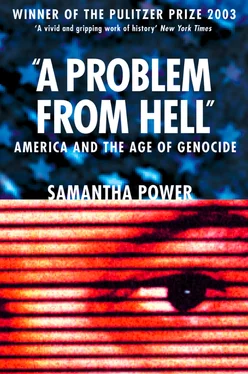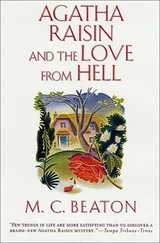Certainly, it is impossible to overstate the importance of the historical context in dictating America’s response to atrocities in Cambodia. Neither President Ford nor President Carter, who took office in January 1977, was going to consider sending U.S. troops back to Southeast Asia. But it is still striking that so many Americans concluded that nothing at all could be done. Even the “soft” response options that were available to the United States were passed up.
The United States barely denounced the massacres. The Ford administration had initially done so, but official U.S. reprimands proved shortlived, as Washington tuned out. Twining, the designated Cambodia watcher at the U.S. embassy in Bangkok, continued collecting and passing along hefty and chilling refugee accounts. 93But these reports led only to a low-key U.S. government request to Amnesty International to begin investigations. A confidential June 8, 1976, policy paper on human rights from the State Department to embassy posts contained the following press guidance:
We share the concern about reported conditions in Cambodia…We are prepared to support any effective action that might be taken to inquire further into the question of violations of human rights in Cambodia…Reports of conditions in Cambodia are…difficult to verify.Information available to the [U.S.government] is not significantly different from that obtained by journalists and comes primarily from refugees. Nevertheless, these reports are too numerous to ignore and sufficient information certainly exists for further inquiry by appropriate international or private humanitarian organizations.
…We have already urged Amnesty International to investigate the situation in Cambodia but have avoided any public actions which would give the appearance of leading a campaign against Cambodia or would lend credence to Cambodian allegations that we are behind reports of their transgressions. 94
Apart from casual appeals for “further inquiry,” the United States did not itself launch its own determined inquiry or act upon the facts already acquired.
U.S. officials could have publicly branded Pol Pot’s killings as genocide. But they did not do so. Indeed, I have not found a U.S. official who remembers even reading the genocide convention to see if events in Cambodia met its requirements. Because the treaty excluded political groups and so many of the KR murders were committed against perceived political enemies, it was actually a harder fit than one would expect. But even though many killings met the law’s terms, no faction emerged inside the Carter administration arguing for any change in U.S. policy toward Cambodia. Thus, it is not surprising that nobody thought to ask the State Department legal adviser’s office to issue a legal finding of genocide. Such a finding would have been moot in the face of the “reality” of U.S. nonengagement. And since the United States was not a party to the convention, a genocide proclamation would have created no legal obligation to act.
The United States could have urged its allies to file genocide charges at the International Court of Justice. The court could not weigh in on individual criminal guilt and had no enforcement powers to ensure its rulings were heeded. But if it had determined that genocide was under way, the ICJ could have issued a declaratory judgment on Cambodia’s responsibility and demanded that provisional measures be taken. This would have signaled to Cambodians that at least one institution was prepared to judge the KR slaughter.
Proxmire hoped that the United States might turn to the ICJ for a genocide finding, but he knew U.S. ratification of the genocide convention had to come first. By the beginning of 1977, it had been a decade since he had started delivering his daily speech urging ratification. In ten years he had stood up 1,761 times, drawing frequently upon the “textbook case of genocide” being committed by the Khmer Rouge. 95In 1977 and 1978 Proxmire ratcheted up his attention to the KR. “The destruction of 2 million Cambodians is the numerical equivalent of murdering every man, woman, and child in the entire state of Colorado,” he declared. “Every human being in Boston, Massachusetts. Every person in Washington, DC—and that includes you and me.” The numbers of victims was still disputed, but he knew he would be better off estimating than waiting. “As we leave the Senate tonight, the Khmer Rouge will be awakening for another bloody day’s business,” he said. “The noose of genocide will tighten with a jerk around the necks of another 1,577 Cambodian peasants.” 96Even those countries that had ratified the convention deferred to diplomatic niceties among states; other countries resisted and refused to challenge a fellow member of the club of nations in court. Cambodia, which itself had ratified the genocide treaty in 1951, never had to answer to genocide charges.
Apart from bilaterally denouncing the KR for its terror or attempting to get an ally to file a genocide case in the World Court, the United States might have condemned the crime in the UN General Assembly, the Security Council, or one of the multiple committees at the UN that had sprung up since Lemkin’s day. Neither the United States nor its European allies did this. Israel became the first country to raise the issue of Cambodia at the United Nations. Representative Chaim Herzog, knowing that much of the violence was Khmer on Khmer, warned of “auto-genocide.” 97And finally, in March 1978, Britain’s UN representative responded to popular pressure from the main churches of England by raising the subject before the UN Commission on Human Rights (UNCHR). He called for the appointment of a special human rights rapporteur to investigate. 98The Khmer Rouge dismissed the Human Rights Commission as an imperialist, partisan body of which it would make “mincemeat.” 99And true to form, the Soviet Union, Yugoslavia, and Syria teamed up to block even this rhetorical route, delaying consideration of Cambodia’s human rights record for another full year. By three years into the genocide, no official UN body had condemned the slaughter.
Economist Albert Hirschman observed that those who do not want to act cite the futility, perversity, and jeopardy of proposed measures. The United States and its allies defended their reticence on the grounds that speaking out or applying soft sanctions to such a reclusive regime would be futile. Normal diplomatic demarches, symbolic acts, and criticisms were unlikely to affect radical revolutionaries who were committing atrocity on this scale. In testimony on Capitol Hill, foreign service officer Twining noted, “I am not sure that the Cambodian leadership would care a hoot about what we…say.” 100Because the United States gave the KR regime no support, it could not suspend trade or military aid.
Bilateral denunciations by the United States may well have had little effect on the Khmer Rouge’s internal practices. Unfortunately, because so few U.S. officials spoke out publicly against the genocide, we cannot know. But contrary to American claims, the Khmer Rouge were not completely oblivious to outside commentary. Isolated though they were, KR leaders still piped up to refute allegations made by foreign powers. When the British raised the issue of Cambodian human rights violations at the UN Commission in Geneva, the KR responded by claiming that British citizens enjoyed only the right to be slaves, thieves, prostitutes, or unemployed. In April 1978 the KR’s Ieng Sary submitted a letter to the UN, denouncing the “propaganda machine of the imperialists, the expansionists, annexationists” who charged them with mass killing. He made a logical argument about why the KR could never kill on the scale suggested:“There is no reason for the [KR] to reduce the population or to maintain it at its current level,” he wrote, “since today’s population of 8 million is well below the potential of the country, which needs more than 20 million.” 101
Читать дальше












